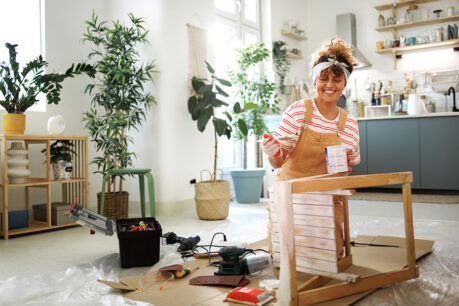
Chances are if you haven’t been to art school or taken an art class, you may have minimal knowledge about color theory. There may be some colors that make you happy and others that make you excited, but did you know that applies to your home as well?
When you paint your walls or bring in furniture, be mindful that specific colors can evoke some specific emotions and moods. So, before you bust out a paint can to update your living room walls or buy that azure armoire for your bedroom, you may want to take color theory into consideration first.
What’s Color Theory?
Take a look at different brands and their color choices for their logo and overall feel. Those choices are intentional. Color theory refers to how different colors work together and how they affect our perceptions and moods.
For example, many food brands and restaurants use reds to stimulate appetite and show passion and yellows to emulate happiness and a warm, inviting nature. In contrast, technology companies often use shades of blue to be associated with stability and success.
When you’re deciding on different colors for your home, you may want to take some extra time to think about what kinds of feelings you want to evoke. How do you want guests to feel when they enter your home? What kind of mood do you want to emulate in your bedroom? Should your bathroom feel powerful and passionate? These are the questions you should ask yourself when thinking about the look and feel of your home.
Colors
Which colors conjure which emotions? It’s important to understand your color choices are deeply personal and that there are no wrong answers when it comes to decorating your home the way you want to.
That said, there are common emotions and moods that are associated with different colors. Take the following section as a guide but remember: There are no hard and fast rules.
Reds
As previously mentioned, the color red can evoke feelings of passion, warmth and excitement. If you want to feel more strength and energy in a certain room, you may want to consider a shade of red.
Yellows
You may already know that yellow is associated with joy, happiness, cheerfulness and optimism as you may relate the color to sunshine and spring. It’s often said that yellow is an emotional color and is psychologically the strongest color.
Greens
Have you ever heard of green therapy? This refers to spending time in nature to relax and regulate your stress. You may be able to bring this theory into your home by painting your walls green or bringing in green furniture.
Blues
Blue often evokes the feeling of calmness, serenity and focus. However, darker shades of blue can do the opposite: Making you feel sadness or general lack of emotion.
Whites
While white can make your rooms seem more spacious and cleaner, it can also appear sterile and unwelcoming. In place of a stark white color, you may want to consider other warmer shades of white like eggshell or cream to make it seem less uncompromising.
Greys
Grey typically doesn’t have any psychological properties, but since it’s technically a lack of color, it can feel depressing and lethargic. However, the positive to grey is that it’s neutral, and some grey shades can complement a bright, colorful room.
Neutrals
Colors like browns, beiges, taupes and other earthy tones can feel warm and cozy, depending on the shade. Neutrals can also be used to accent rooms (such as with furniture) as they’re easy to complement many other colors.
Shades
Colors in general aren’t the only factors in evoking emotion. The shade of the color can also play a part in reflecting a room’s mood. Learning to understand how light and dark shades impact the room can help you be mindful in creating the atmosphere you want in specific areas in your home.
Light Shades
Lighter shades, such as pastels and soft tones, can reflect a sense of calm, tranquility and serenity. Some examples include pastel pink or sky blue.
Dark Shades
In contrast, darker shades such as royal purple or a deep, rich blue can feel more intense and conjure up feelings of mystery and introspection.
Colors Make the Home
As you’re going through your home and thinking about the emotional states you want to induce in each room, be mindful of your paint and furniture colors and shades. While the colors you bring into your home are personal and subjective, there are universal feelings that specific colors represent and elicit.
A good guide is to consider the function of the room as you’re choosing colors. You may want to feel more at peace and restful in your bedroom as you’re getting ready for sleep, so you may want to bring in lighter shades of blue or green. On the other hand, a home office may benefit from darker, richer colors like red to reflect productivity and energy.
No matter what colors you choose, remember that these hues can affect the life you live in your home.
This information is intended for educational purposes only. Products and interest rates subject to change without notice. Loan products are subject to credit approval and include terms and conditions, fees and other costs. Terms and conditions may apply. Property insurance is required on all loans secured by property. VA loan products are subject to VA eligibility requirements. Adjustable Rate Mortgage (ARM) interest rates and monthly payment are subject to adjustment. Upon submission of a full application, a mortgage banker will review and provide you with the terms, conditions, disclosures, and additional details on the interest rates that apply to your individual situation.


